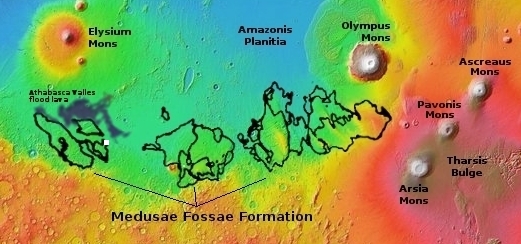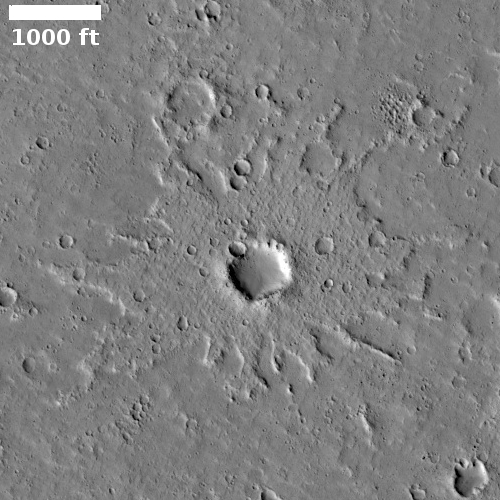A splat on Mars
Cool image time! The photo to the right, cropped to post here, was taken on October 31, 2020 by the high resolution camera on Mars Reconnaissance Orbiter (MRO). Labelled simply as a “Terrain Sample”, it was not taken as part of any specific science research but because the MRO science team need to regularly take pictures to maintain the camera’s temperature. When such engineering images are required they try to pick spots of some interest, but sometimes the resulting picture is somewhat bland.
If you look at the full image, you will see that blandness generally describes it. However, in the upper left corner was a most intriguing-looking crater, which I have focused on above. From all appearances, when this impact happened the ground was quite soft, almost like mud, and thus the ejecta splattered away not as individual rocks and debris but as a flow.
The map below gives a little context, but really doesn’t explain this crater fully.

The white box indicates the location of this crater. It is right on the edge of the Medusae Fossae Formation, a gigantic field of volcanic ash about the size of India from which most of the dust on Mars is thought to come.
However, the number of craters in the full image suggests we are not looking at that ash field. Other images of the Medusae formation (see this one for example) generally show a craterless terrain, the craters buried by the more recent ash fall.
The number of craters also suggests that the surface here is not a lava flood plain. The nearby recent lava flows, such as the Athabasca Valles flood lava, wipe away the craters to leave a smooth plain (see this image for example).
It is possible the craters were caused by the spray of secondary ejecta from a more recent nearby large impact. To the southwest of this image is such a larger crater, but I do not know when that impact occurred.
The latitude is 2 degrees south, so this is right on the equator. We would not expect to see buried ice here, or at least, if there is, it will be deep underground and would likely not have caused this feature.
The only explanation that comes to my mind is that this impact is old, and that it happened when the planet’s equatorial tilt was much greater, and this location was at a higher latitude, when ice might have been more present.
To put it mildly, I do not take that explanation very seriously. We have here a mystery, something that is not unusual when you look closely at the surface of Mars. This mystery however is not readily explained by what I so far know of Mars.
On Christmas Eve 1968 three Americans became the first humans to visit another world. What they did to celebrate was unexpected and profound, and will be remembered throughout all human history. Genesis: the Story of Apollo 8, Robert Zimmerman's classic history of humanity's first journey to another world, tells that story, and it is now available as both an ebook and an audiobook, both with a foreword by Valerie Anders and a new introduction by Robert Zimmerman.
The print edition can be purchased at Amazon or from any other book seller. If you want an autographed copy the price is $60 for the hardback and $45 for the paperback, plus $8 shipping for each. Go here for purchasing details. The ebook is available everywhere for $5.99 (before discount) at amazon, or direct from my ebook publisher, ebookit. If you buy it from ebookit you don't support the big tech companies and the author gets a bigger cut much sooner.
The audiobook is also available at all these vendors, and is also free with a 30-day trial membership to Audible.
"Not simply about one mission, [Genesis] is also the history of America's quest for the moon... Zimmerman has done a masterful job of tying disparate events together into a solid account of one of America's greatest human triumphs."--San Antonio Express-News
Cool image time! The photo to the right, cropped to post here, was taken on October 31, 2020 by the high resolution camera on Mars Reconnaissance Orbiter (MRO). Labelled simply as a “Terrain Sample”, it was not taken as part of any specific science research but because the MRO science team need to regularly take pictures to maintain the camera’s temperature. When such engineering images are required they try to pick spots of some interest, but sometimes the resulting picture is somewhat bland.
If you look at the full image, you will see that blandness generally describes it. However, in the upper left corner was a most intriguing-looking crater, which I have focused on above. From all appearances, when this impact happened the ground was quite soft, almost like mud, and thus the ejecta splattered away not as individual rocks and debris but as a flow.
The map below gives a little context, but really doesn’t explain this crater fully.

The white box indicates the location of this crater. It is right on the edge of the Medusae Fossae Formation, a gigantic field of volcanic ash about the size of India from which most of the dust on Mars is thought to come.
However, the number of craters in the full image suggests we are not looking at that ash field. Other images of the Medusae formation (see this one for example) generally show a craterless terrain, the craters buried by the more recent ash fall.
The number of craters also suggests that the surface here is not a lava flood plain. The nearby recent lava flows, such as the Athabasca Valles flood lava, wipe away the craters to leave a smooth plain (see this image for example).
It is possible the craters were caused by the spray of secondary ejecta from a more recent nearby large impact. To the southwest of this image is such a larger crater, but I do not know when that impact occurred.
The latitude is 2 degrees south, so this is right on the equator. We would not expect to see buried ice here, or at least, if there is, it will be deep underground and would likely not have caused this feature.
The only explanation that comes to my mind is that this impact is old, and that it happened when the planet’s equatorial tilt was much greater, and this location was at a higher latitude, when ice might have been more present.
To put it mildly, I do not take that explanation very seriously. We have here a mystery, something that is not unusual when you look closely at the surface of Mars. This mystery however is not readily explained by what I so far know of Mars.
On Christmas Eve 1968 three Americans became the first humans to visit another world. What they did to celebrate was unexpected and profound, and will be remembered throughout all human history. Genesis: the Story of Apollo 8, Robert Zimmerman's classic history of humanity's first journey to another world, tells that story, and it is now available as both an ebook and an audiobook, both with a foreword by Valerie Anders and a new introduction by Robert Zimmerman.
The print edition can be purchased at Amazon or from any other book seller. If you want an autographed copy the price is $60 for the hardback and $45 for the paperback, plus $8 shipping for each. Go here for purchasing details. The ebook is available everywhere for $5.99 (before discount) at amazon, or direct from my ebook publisher, ebookit. If you buy it from ebookit you don't support the big tech companies and the author gets a bigger cut much sooner.
The audiobook is also available at all these vendors, and is also free with a 30-day trial membership to Audible.
"Not simply about one mission, [Genesis] is also the history of America's quest for the moon... Zimmerman has done a masterful job of tying disparate events together into a solid account of one of America's greatest human triumphs."--San Antonio Express-News



So, what on Mars is that cluster of craters to the upper right? Some sort of rubble like hitting Mars?
DougSpace: That cluster could either have been a meteorite breaking up as it came in, or a bunch of secondaries from another impact. In either case, I suspect they are all related to the same event..
I searched over the entire picture and only found one more splat comet impact, but it’s much older and less defined. It’s slightly above exact center of the original picture. I’m thinking that this unusual crater is an anomaly, not common. It probably says more about the composition of the meteor than it does about the landscape? No, I guess not.
An ice ball would have vaporized, not created mud.
But what is very interesting is the blow hole window in the lower left. Another window near by, center bottom and a small volcano at the far right. The wispy shadows don’t match the ridge line, that’s unusual. I’m thinking they captured wind blowing sand casting a shadow. Or it could be just unusual looking dark dunes downhill from the volcano. Not so bland after all.
I believe the common understanding is for a meteor to consist of something akin to a hard rock.
What if the meteor was much softer, something that would deform quicker than the surface it struck?
These Martian splats are common are they not?